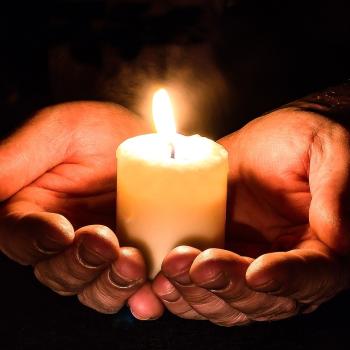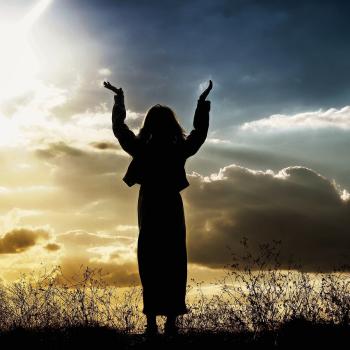As was noted in the Part I of this series, prayer is traditionally thought of as a person or agent of lower power, entreating one of greater power to effect changes in one’s world of experience — usually those changes that are beyond the ability of the pray-er to effect of their own ability. Sometimes this might involve simple alterations to the course of normal life events. At other times, it might require the working of miracles — changes that would violate known laws of physics or physical processes (spiritual “healing” for example).
Especially in the latter case, such change would seem to require supernatural intervention by a superior agency — an other — distinct from ourselves. In religious contexts this is commonly thought of as “God”.
However, as was also suggested in Part I, the above view may correspond to an earlier stage of developmental spirituality — a childhood phase. At the current stage in the mental, moral, and spiritual development of our species and culture, we may now be called to a more proactive role, assuming the responsibilities of spiritual adulthood.
Yet since we humans are generally not supernatural, how else might this work? The following is an attempt to update ancient notions of prayer and its effects in view of current understanding in areas of physics, cosmology, and the psychological sciences. This would likely begin with an expanded view of the cosmos.
The Ground of Being
The Hindu ancients held that the cosmos emerges from a subtle substance “akasha”, as animated by a life-force “prana”. The counterpart mechanics in Western religions generally involve a personified God, creating the world of nature from “word” or “waters” or “clay”.
Western religions tend to center on the notion of a personified deity or God — one who possesses traits similar to our own — thoughts, feeling, desires, plans — and one who might take action based on our own needs and desires. Such an entity would of course be supremely conscious.
Interestingly, in contemporary science, the Eastern perspective has a somewhat similar counterpart in the notion of universal fields, “quantum foam”, and the role of a conscious observer who “collapses” a wave of probabilities into one fixed, persistent reality.
Perhaps a bridge or synthesis between the ancient and the modern concepts — religion and science — lies in the meaning and interpretation of ‘consciousness’ and ‘conscious observer’.
A Continuum of Consciousness
Traditional religions and philosophies commonly place God and Human (or divine and mortal) in two separate and distinct realms. In contrast, in a consciousness-primary cosmos, there is no hard division but more a continuum — sort of like the slider on a light-dimming switch — between individual subjectivity and cosmic, divine wholeness. If that is the case, certain practices might enable the “slider” of individual consciousness to be moved up in such a way to enable the ability to perceive and affect experienced reality in ways that are currently considered supernormal. Perhaps this is also the basis of paranormal or “psychic” phenomena.
For present purposes, it might also play a role in increasing the effectiveness of prayer.
Momentarily Transcending the Conventional World
If prayer is an intention or hope for a change in circumstance or physical configuration in the conventional world, the means and impetus for such change would need to originate from outside of conventional reality. Otherwise, it would simply be a matter of human actors doing what humans are capable of doing.
The above is easy to understand in traditional religious contexts, where a supernormal force (e.g. God) can be entreated to make supernormal alterations to our experienced reality. Even so, in such a context, are we humans afforded the ability to act beyond conventional means as we mature in knowledge and experience? Interestingly, elements of Quantum Theory suggest the answer might be “yes”.
The Observer Effect
Even today, our eons of experience in the physical world make it difficult to escape the sense that there is a fixed, physical, tangible world “out there” — one that persists whether or not you or I are around to experience and appreciate it. However, the popular interpretation of Quantum Mechanics (QM), along with a new resurgence in the philosophy of Idealism, suggests that this is not exactly the case. These hold that at the most basic level, the universe consists of clouds of potential (the “fields” of Quantum Field Theory) which only collapse into a fixed state when a measurement (observation) is made. In other words, an observer is an essential ingredient in the way a stable experience of reality emerges. In particular, a conscious observer. As noted in an earlier section, most common human affairs are a product of individual human observers whereas globally or cosmically experienced events derive from consciousness at a grander scale.
Beyond Cause and Effect
Because our experience in the world occurs as a flow of time rather than an eternal “Now”, it is difficult not to see events as occurring in a sequence of causes and effects.
Accordingly, when we hope for a change in some aspect of our experienced reality (i.e. anything that we might “pray” for) it is hard not to think of a prayer request as the cause (or the trigger for a cause) that might produce the desired effect (i.e. the answer to the prayer). This implies an arrow of time — cause precedes effect, and effect follows a prior cause.
Yet the means for any such supernormal occurrence would have to reside above the level of conventional reality. ‘Time’ however, is simply one of the dimensions of conventional spacetime reality. (As one proceeds up the dimensional ladder: point, line, plane, volume, volume over time, all lower dimensions become simultaneous.) Difficult as it may be to comprehend, at levels of reality more comprehensive than Spacetime, “before” and “after” are not meaningful concepts — all is an eternal “Now”. (Refer to earlier section “What is Time?” for an elaboration of “block time”.)
If the above is the case, in order for prayer to be a meaningful, useful concept, what else might be going on?
Modularity, Concurrency, and Parallel Realities
Given day-to-day experience, it is difficult to see an apparent flow of cause and effect events as one unitary phenomenon. Every event, outcome, or result seems to derive from a prior cause or intention. Indeed, science is largely about determining which factors and conditions (cause) will reliably produce particular results (effect).
Philosopher Alan Watts (popular for introducing Eastern thought to the West) once used the following analogy. Imagine looking at a wooden fence that has a gap in one of the slats. A cat is pacing back and forth past the gap. First, one sees the head, then the tail. The cat then walks back the other way — first the head, then the tail. Since the head always precedes the tail, having no other information, one might conclude that the head is the cause of the tail. However, were the limiting perspective of the fence removed, one can now see that it is just one single phenomenon: a cat!
Assuming that our world emerges from a cosmic sea of all possible realities — realities which further coexist concurrently in an eternal Now — in order for our day-to-day experience to proceed as it does, consciousness must impose the “fence” of ‘time’. (“Time is what keeps everything from happening all at once.” — a quip by John Archibald Wheeler, quoting SciFi writer Ray Cummings.)
Impossible as it may be to fully appreciate, causes and effects may simply be aspects of one unitary pattern, occurring along one set of event-lines. In other parallel event-line modules, these phenomena may have alternative forms that manifest as different histories. In terms of Einstein’s “block universe” as described earlier, all elements of an event exist simultaneously within the block.
Again, the current proposal is that our total experience of the world is a vast complex of assembled modules — each of which is a somewhat pre-packaged set of events that we experience as the people, places and things, the thoughts, feelings, and actions — all elements that in combination, provide our experience of living in the world.
Note further that even our self-concept, our personality, is essentially a collection of modules of past memory and experience. Have you ever acted “out of character”? Perhaps a gentle person experiencing a moment of road-rage? Maybe a compassionate, generous person having a moment of cruelty or stinginess? To the extent that our reality is assembled moment-by-moment, sometimes in haste, we may grab the wrong module. In the most extreme cases, this may be the basis of dissociative identity disorder (formerly “multiple personality disorder”).
As suggested above, our proposal is that many of these elements — these pre-packaged modules — are interchangeable. Accordingly, an alteration in one aspect of experienced reality does not require an entirely new parallel reality or universe (the popular understanding of the “Many Worlds Hypothesis”). Of course the process is more subtle and complex than changing your socks, but the principle is similar.
The above may be the effective mechanism behind prayer — a collective observational shift to an alternative set of event-lines with a more desirable outcome.
Note that this does not necessarily require something magical or miraculous. Most of life’s events can unfold in multiple ways with multiple outcomes. Prayer in many cases may simply be a desire or intention to manifest an alternative set of event-lines.
Next week we will continue this series on What is Prayer? with a brief re-cap and a look at the practice of prayer and the limitations of language.
Image by Gordon Johnson from Pixabay













